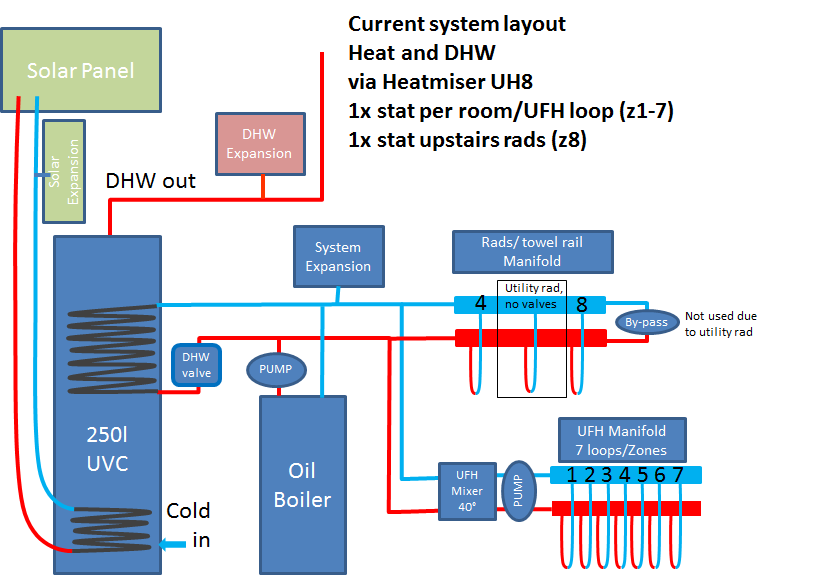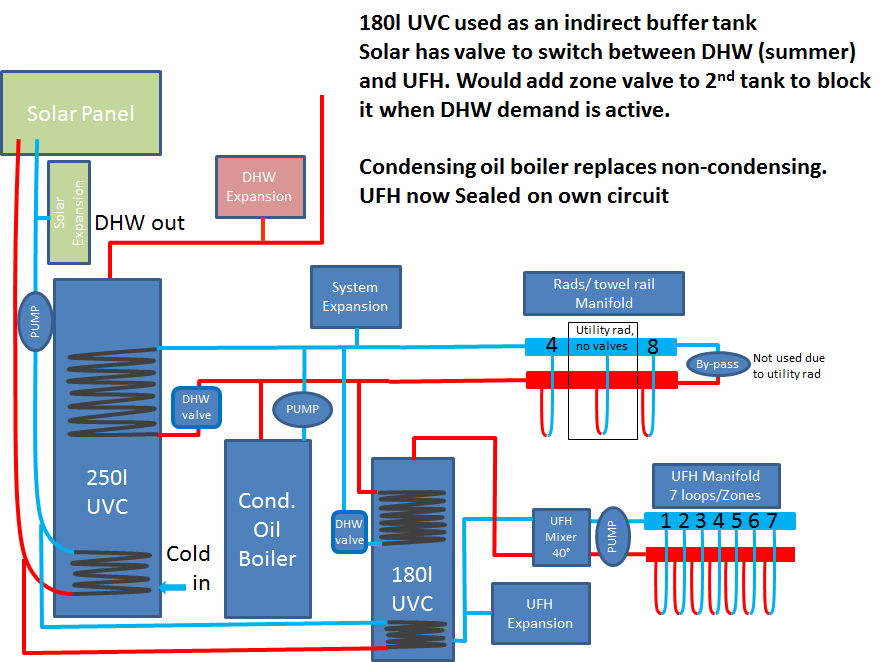
thompo5015
Members-
Posts
7 -
Joined
-
Last visited
Personal Information
-
About Me
Engineer/ Tinkerer
-
Location
Co.Down Northern ireland
Recent Profile Visitors
The recent visitors block is disabled and is not being shown to other users.
thompo5015's Achievements

New Member (2/5)
0
Reputation
-
Hello, I currently have an old oil boiler running downstairs UFH + a towel rail and 4 rads. I have a Condensing oil boiler to replace the old one, i have read some stuff about return temperatures having to be controlled by a mixing valve to ensure max efficiency and eliminate heat exchanger corrosion??, Is this necessary? I haven't found one in any of my friends or families houses and the literature for the boiler does not mention anything (Warmflow Kabinpak) Looking at the installation above is a condensing boiler a simple replacement with no added mixers etc? I have a spare twincoil 180l UVC and i have toyed with the idea of using it as a buffer for the UFH and also allow solar to help with heating vs DHW in winter but im unsure of the execution... I can put a manual valve or (zone valve) on the solar to divert flow and make a box to switch the controller from 1 set of tank probes to the other. Option to put a zone valve linked to the DHW demand to isolate the 2nd cylinder when DHW is needed to boost heatup. Away from the solar would something as basic as this arrangement below give any savings? - I know a thermal store is the answer but budget doesn't go that far at the min and as i have most of this stuff, only cost will be a zone valve, expansion vessel and a bit of time. Stats would be set to fire boiler when the top of cylinder falls below 40 and off when bottom hits 60 or boiler flow temp. Any benefit heating the 2nd cylinder directly along with the UFH or having the UFH draw off via a coil? Thanks for any info.
-
Old cold roof to Modern warm roof
thompo5015 replied to thompo5015's topic in Roofing, Tiling & Slating
Cheers for the reply, I would hope to incorporate the sprayed foam into the proposed new roof structure when the time comes, so I view it as a 1st stage rather than temporary solution lol. Upstairs currently is only heated when the stat calls for frost protection. Would prefer to keep the floor intact, as it is sound and I fear lifting it would leave it squeaky or needing replaced. We had a lot of the tiles up when removing Chimney stacks at either end of the place and installing the solar panel. I had a roofer give structure a once over when resetting the hip ridges and he didn't see any problems and was surprised it was so solid with timbers half the size of a modern build, probably due to the sarking tying it all together. No rot visible anywhere from the inside and its bone dry during/after storms. Sarking is a good fit, no gaps greater 5mm (odd knot that dropped out) and this is covered by felt so any bleed through of the spray would be stopped by the felt. Agreed we wouldn't know the full extent of any sarking issues until the felt is removed. I had previously thought of lining the inside of the sarking with some paper to break the majority of the bond from foam to wood, allowing complete removal of sarking to get insulation to insulation contact when going to the next stage rather than encapsulating the existing sarking. -
Hello, We currently have a roof from around 1950s consisting of Plasterboard, 45x100mm rafters, Sarking boards, felt then concrete tiles . There has been an attic conversion carried out (no planning) around the 80s and we have zero insulation Would like to convert it to a warm roof with decent insulation 2-300mm, but this wont be for a few years. In order to insulate for now im wondering if this would have any detrimental effects and could be incorporated into the conversion to a warm roof..... Full fill the 100mm with an open cell spray foam, I know some folk will shudder at this thought!. Cost and U-value is comparable to EPS but install time is Hrs vs days because no 2 rafters are the same spacing or parallel to each other! PIR obviously better but cost/install time again, sprayed equivalent closed cell foam is 4x the price for same thickness! I know the rafters are meant to breathe, currently and probably since the roof went on, sofits and eaves are completely enclosed, standing in the attic rooms with no plasterboard and a howling wind, the only air movement comes from a poorly sealed velux. All timbers are sound and show no signs of degradation. Would like to convert it to warm roof in couple of years by Remove tiles and felt. Cross batten onto the sarking boards (to maintain airtight seal with spray foam) Fit 2-300mm EPS, batten again and install a composite/lightweight tile rather than concrete to keep total weight comparable with existing, keeping main structure of roof intact. This allows us to extend the eaves to tie in with planned EWI that should give us good airtightness and eliminate any thermal bridges. Is it a viable option to effectively sandwhich the existing sarking in a warm roof conversion? Any thoughts? Cheers
-
The buffer would be beside the UVC in the utility room, along with wash machine and tumble. Standing losses would contribute little to heating the rest of the place, we are only ever in there when we need to be and door closed when machines are going. I had planned for a Thermal store at the outset and got talked out of it by 3 different plumbers when I was getting quotes as "gas was coming". Ended up getting a great deal on UVC and fitted DIY, with 1 of the above plumbers coming to check and sign it off. Gas came about 6months ago, the main runs past my drive way but I cant get it because the nearest low pressure supply stopped 600m down the road where the housing developments end Would need weigh up cost of TS and savings Vs cost of buffer. Agree TS would have been the way to go! Floor upstairs is chip board or 16mm floor boards. Given that we hope to have a warm roof + EWI (tea cosy idea) id prefer not to insulate the attic from any escaping heat below as it will be useful at some stage lol. Ill start a thread in the relevant section on insulating the roof, got a couple of ideas. Thanks
-
Hello, I currently have an ancient Grant 70/90 with reilio burner running sealed and feeding a 250l unvented cylinder with 30tube solar for DHW, 3 small rads upstairs, 1 towel rail and ground floor UFH (150mm centres and Gypsum screed, tile floors) split into 7 zones + rads& DHW, all hooked up through a Heatmiser UH1. Heating a 90m sq bungalow with attic conversion, solid brick walls and no insulation in roof, (solid floor has 100mm PIR though) needless to say insulation would be best option to curb excessive oil use but as we could be doing with a new roof and render in the next few years, that = new warm roof, dormer extension and EWI but thats a few years off yet. Winter sees us get through 500l of oil a month, Mrs will be at home with baby this year so id like to cut this (oil use! not the mrs and kids)... I have been given a 2008 vintage Warmflow 70 condensing boiler with only 6 months use (boiler replaced, house sold to a family friend, he fitted gas when moving in and its sat until they have decided to move again) Whilst it should be more efficient than my old boiler its still going to suffer from short cycling due to UFH only needing low temp and oil not modulating. I have found a used 200l Twin coil cylinder for not a lot. Not sure if it was destined to be sealed or vented, haven't looked it over yet. My thinking.... is to use this as a buffer tank, just not sure on how best to hook it up. Current plan connect UFH with the 200l tank, heated from top down by the indirect coil to 40 -50deg to minimise standing losses, 2 stats to control boiler demand, Or is it best to heat to normal temp of boiler and let the UFH manifold mix it down? Solar linked into 2nd buffer coil and swapped manually with a valve for summer/winter to help with space heating or DHW (could be automated to do either or both with right logic). It currently lifts the DHW to around 25-30ºC during winter sun so that isn't far off the UFH temp and should help. Boiler remains sealed and supplies the DHW coil, buffer tank coil and rads/towel rail direct. I see this as giving quick heat up for the rads/towel rail/DHW coil (direct and sealed to minimise corrosion in rads/boiler) and putting a larger load to help stop cycling when UFH is required, corrosion should be less of an issue with the UFH as the only metal component is the manifold and valves. Heating the buffer top down should allow the UFH to draw warm water quicker than waiting for the full 200l to heat? Would this work, if so how best to optimise for condensing operation? Is it likely to save more than the £200 or so it could cost to implement (DIY, no changes to unvented cylinder required.) Cheers for any advice.
-
Hi folks, just found this place after looking for some info online. Bought a 1920s solid wall bungalow with attic conversion as our 1st house and working at renovating to a decent level of insulation and efficiency, don't plan on moving as its got most of what we want so its a long term project. I do most of the work myself except for plastering/brick laying and where its more cost effective than hire/buy specialist tools. Done a fair bit, new floors, plumbing, UFH, solar DHW, tiling, stove, bathroom, trench excavation for electric etc Immediate plans Insulate existing roof either on the cheap as it may be replaced in a few years/or in a way that can be incorporated into new roof (only 100mm rafters though) Curb oil use as best possible until insulation is done as mrs will be at home a lot with new baby. Longer term, EWI to fitted and integrated with a warm roof and new windows to hopefully get a good level of insulation and air tightness. If above works MVHR Solar PV to help with electricity. Maybe heatpump to move away from oil. Expect a few queries and ill chip in with help where I can. Cheers


